Analyzing Financial Health: Ratio Analysis in Financial Management
VerifiedAdded on 2023/06/10
|14
|2861
|369
Report
AI Summary
This report delves into the role of financial management in organizational growth, focusing on planning, organizing, monitoring, and controlling financial undertakings. It elucidates financial management concepts, emphasizing the importance of investment, financing, and dividend decisions. The r...

bmp3005
Paraphrase This Document
Need a fresh take? Get an instant paraphrase of this document with our AI Paraphraser
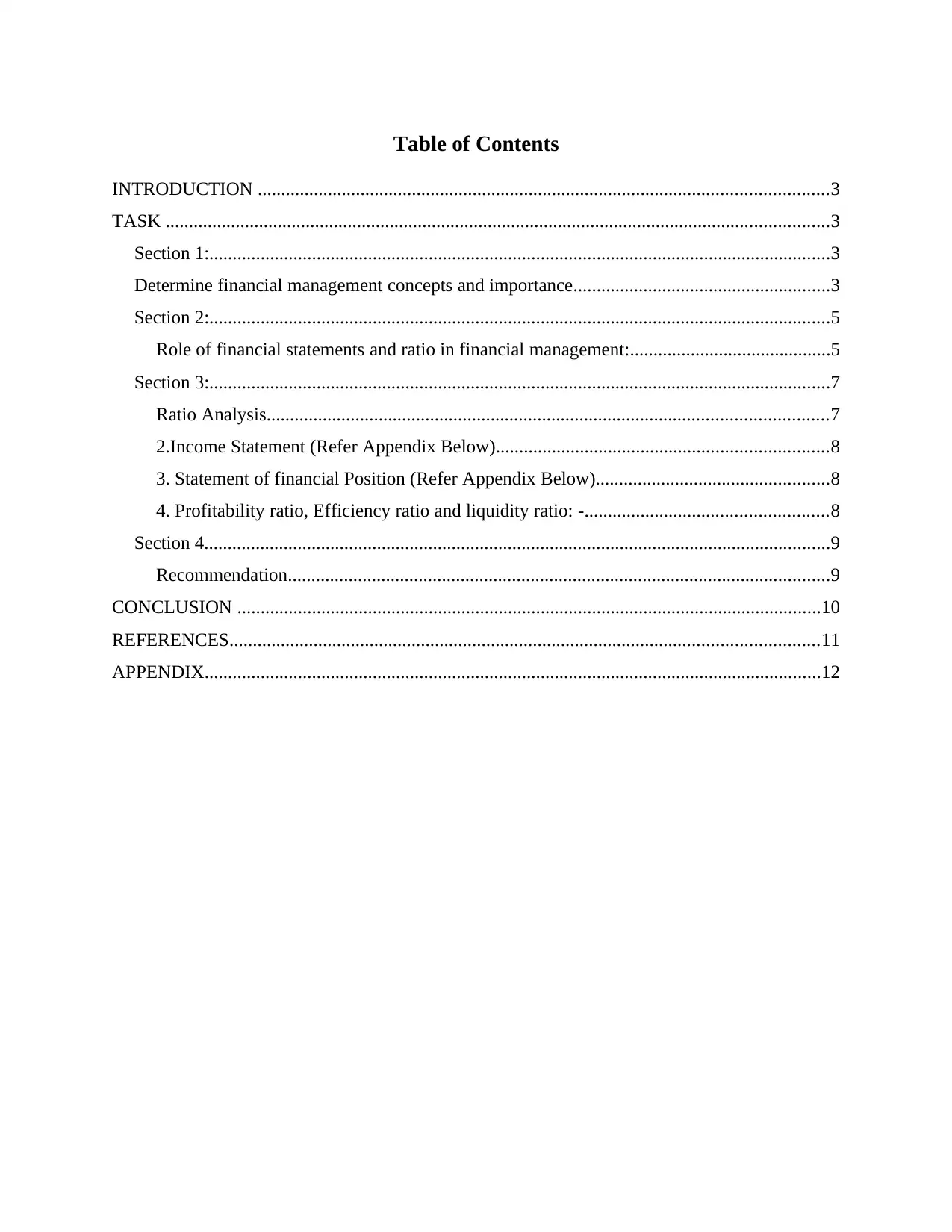
Table of Contents
INTRODUCTION ..........................................................................................................................3
TASK ..............................................................................................................................................3
Section 1:.....................................................................................................................................3
Determine financial management concepts and importance.......................................................3
Section 2:.....................................................................................................................................5
Role of financial statements and ratio in financial management:...........................................5
Section 3:.....................................................................................................................................7
Ratio Analysis........................................................................................................................7
2.Income Statement (Refer Appendix Below).......................................................................8
3. Statement of financial Position (Refer Appendix Below)..................................................8
4. Profitability ratio, Efficiency ratio and liquidity ratio: -....................................................8
Section 4......................................................................................................................................9
Recommendation....................................................................................................................9
CONCLUSION .............................................................................................................................10
REFERENCES..............................................................................................................................11
APPENDIX....................................................................................................................................12
INTRODUCTION ..........................................................................................................................3
TASK ..............................................................................................................................................3
Section 1:.....................................................................................................................................3
Determine financial management concepts and importance.......................................................3
Section 2:.....................................................................................................................................5
Role of financial statements and ratio in financial management:...........................................5
Section 3:.....................................................................................................................................7
Ratio Analysis........................................................................................................................7
2.Income Statement (Refer Appendix Below).......................................................................8
3. Statement of financial Position (Refer Appendix Below)..................................................8
4. Profitability ratio, Efficiency ratio and liquidity ratio: -....................................................8
Section 4......................................................................................................................................9
Recommendation....................................................................................................................9
CONCLUSION .............................................................................................................................10
REFERENCES..............................................................................................................................11
APPENDIX....................................................................................................................................12
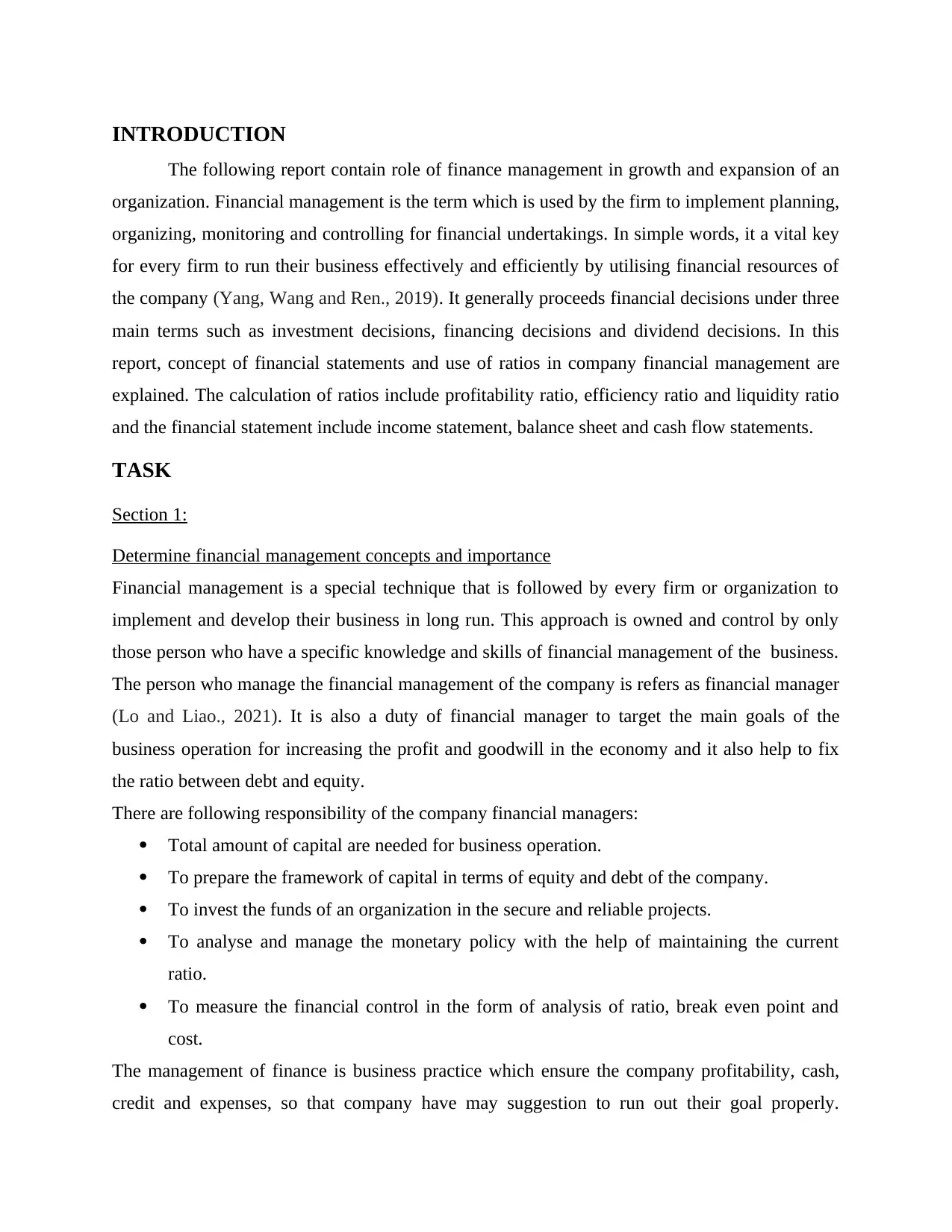
INTRODUCTION
The following report contain role of finance management in growth and expansion of an
organization. Financial management is the term which is used by the firm to implement planning,
organizing, monitoring and controlling for financial undertakings. In simple words, it a vital key
for every firm to run their business effectively and efficiently by utilising financial resources of
the company (Yang, Wang and Ren., 2019). It generally proceeds financial decisions under three
main terms such as investment decisions, financing decisions and dividend decisions. In this
report, concept of financial statements and use of ratios in company financial management are
explained. The calculation of ratios include profitability ratio, efficiency ratio and liquidity ratio
and the financial statement include income statement, balance sheet and cash flow statements.
TASK
Section 1:
Determine financial management concepts and importance
Financial management is a special technique that is followed by every firm or organization to
implement and develop their business in long run. This approach is owned and control by only
those person who have a specific knowledge and skills of financial management of the business.
The person who manage the financial management of the company is refers as financial manager
(Lo and Liao., 2021). It is also a duty of financial manager to target the main goals of the
business operation for increasing the profit and goodwill in the economy and it also help to fix
the ratio between debt and equity.
There are following responsibility of the company financial managers:
Total amount of capital are needed for business operation.
To prepare the framework of capital in terms of equity and debt of the company.
To invest the funds of an organization in the secure and reliable projects.
To analyse and manage the monetary policy with the help of maintaining the current
ratio.
To measure the financial control in the form of analysis of ratio, break even point and
cost.
The management of finance is business practice which ensure the company profitability, cash,
credit and expenses, so that company have may suggestion to run out their goal properly.
The following report contain role of finance management in growth and expansion of an
organization. Financial management is the term which is used by the firm to implement planning,
organizing, monitoring and controlling for financial undertakings. In simple words, it a vital key
for every firm to run their business effectively and efficiently by utilising financial resources of
the company (Yang, Wang and Ren., 2019). It generally proceeds financial decisions under three
main terms such as investment decisions, financing decisions and dividend decisions. In this
report, concept of financial statements and use of ratios in company financial management are
explained. The calculation of ratios include profitability ratio, efficiency ratio and liquidity ratio
and the financial statement include income statement, balance sheet and cash flow statements.
TASK
Section 1:
Determine financial management concepts and importance
Financial management is a special technique that is followed by every firm or organization to
implement and develop their business in long run. This approach is owned and control by only
those person who have a specific knowledge and skills of financial management of the business.
The person who manage the financial management of the company is refers as financial manager
(Lo and Liao., 2021). It is also a duty of financial manager to target the main goals of the
business operation for increasing the profit and goodwill in the economy and it also help to fix
the ratio between debt and equity.
There are following responsibility of the company financial managers:
Total amount of capital are needed for business operation.
To prepare the framework of capital in terms of equity and debt of the company.
To invest the funds of an organization in the secure and reliable projects.
To analyse and manage the monetary policy with the help of maintaining the current
ratio.
To measure the financial control in the form of analysis of ratio, break even point and
cost.
The management of finance is business practice which ensure the company profitability, cash,
credit and expenses, so that company have may suggestion to run out their goal properly.
You're viewing a preview
Unlock full access by subscribing today!
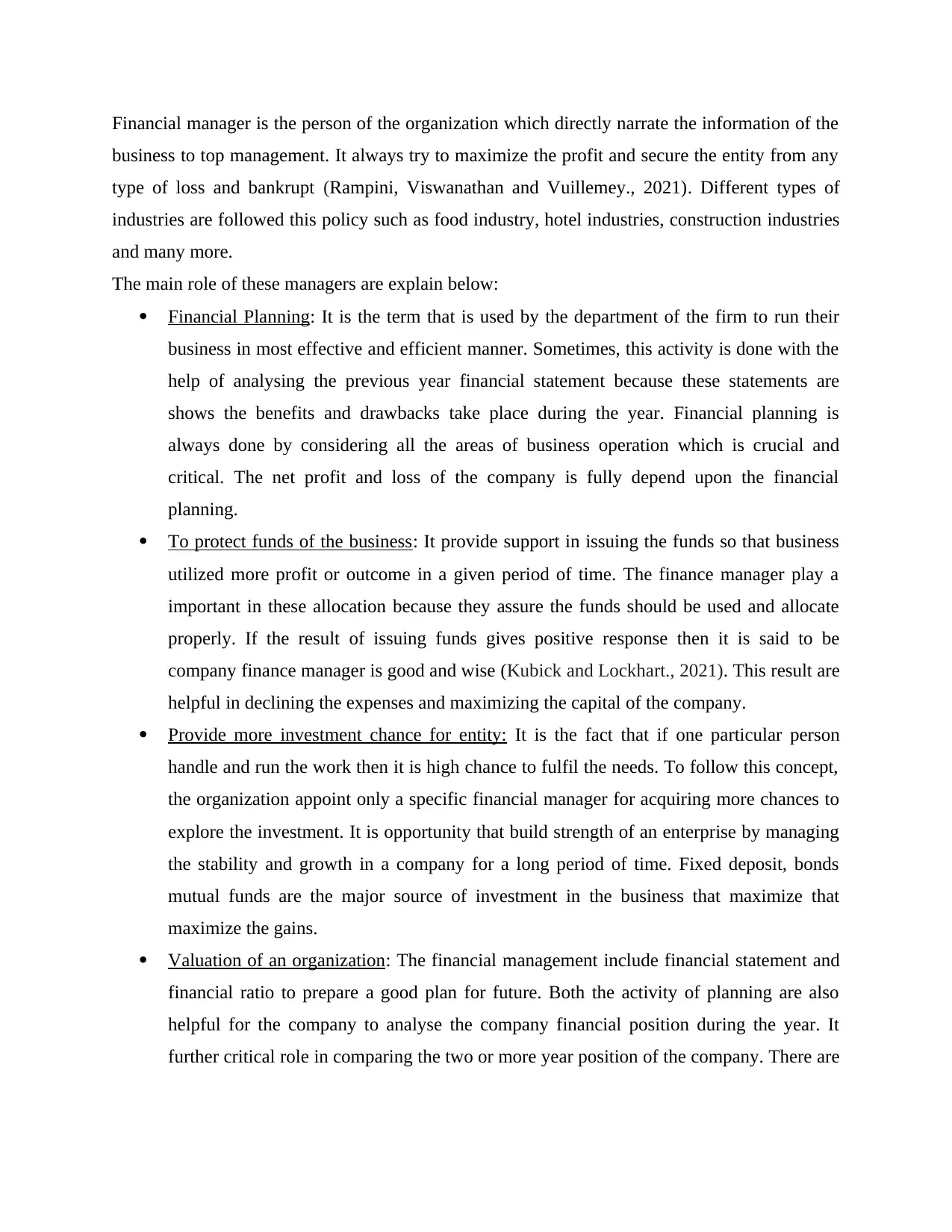
Financial manager is the person of the organization which directly narrate the information of the
business to top management. It always try to maximize the profit and secure the entity from any
type of loss and bankrupt (Rampini, Viswanathan and Vuillemey., 2021). Different types of
industries are followed this policy such as food industry, hotel industries, construction industries
and many more.
The main role of these managers are explain below:
Financial Planning: It is the term that is used by the department of the firm to run their
business in most effective and efficient manner. Sometimes, this activity is done with the
help of analysing the previous year financial statement because these statements are
shows the benefits and drawbacks take place during the year. Financial planning is
always done by considering all the areas of business operation which is crucial and
critical. The net profit and loss of the company is fully depend upon the financial
planning.
To protect funds of the business: It provide support in issuing the funds so that business
utilized more profit or outcome in a given period of time. The finance manager play a
important in these allocation because they assure the funds should be used and allocate
properly. If the result of issuing funds gives positive response then it is said to be
company finance manager is good and wise (Kubick and Lockhart., 2021). This result are
helpful in declining the expenses and maximizing the capital of the company.
Provide more investment chance for entity: It is the fact that if one particular person
handle and run the work then it is high chance to fulfil the needs. To follow this concept,
the organization appoint only a specific financial manager for acquiring more chances to
explore the investment. It is opportunity that build strength of an enterprise by managing
the stability and growth in a company for a long period of time. Fixed deposit, bonds
mutual funds are the major source of investment in the business that maximize that
maximize the gains.
Valuation of an organization: The financial management include financial statement and
financial ratio to prepare a good plan for future. Both the activity of planning are also
helpful for the company to analyse the company financial position during the year. It
further critical role in comparing the two or more year position of the company. There are
business to top management. It always try to maximize the profit and secure the entity from any
type of loss and bankrupt (Rampini, Viswanathan and Vuillemey., 2021). Different types of
industries are followed this policy such as food industry, hotel industries, construction industries
and many more.
The main role of these managers are explain below:
Financial Planning: It is the term that is used by the department of the firm to run their
business in most effective and efficient manner. Sometimes, this activity is done with the
help of analysing the previous year financial statement because these statements are
shows the benefits and drawbacks take place during the year. Financial planning is
always done by considering all the areas of business operation which is crucial and
critical. The net profit and loss of the company is fully depend upon the financial
planning.
To protect funds of the business: It provide support in issuing the funds so that business
utilized more profit or outcome in a given period of time. The finance manager play a
important in these allocation because they assure the funds should be used and allocate
properly. If the result of issuing funds gives positive response then it is said to be
company finance manager is good and wise (Kubick and Lockhart., 2021). This result are
helpful in declining the expenses and maximizing the capital of the company.
Provide more investment chance for entity: It is the fact that if one particular person
handle and run the work then it is high chance to fulfil the needs. To follow this concept,
the organization appoint only a specific financial manager for acquiring more chances to
explore the investment. It is opportunity that build strength of an enterprise by managing
the stability and growth in a company for a long period of time. Fixed deposit, bonds
mutual funds are the major source of investment in the business that maximize that
maximize the gains.
Valuation of an organization: The financial management include financial statement and
financial ratio to prepare a good plan for future. Both the activity of planning are also
helpful for the company to analyse the company financial position during the year. It
further critical role in comparing the two or more year position of the company. There are
Paraphrase This Document
Need a fresh take? Get an instant paraphrase of this document with our AI Paraphraser
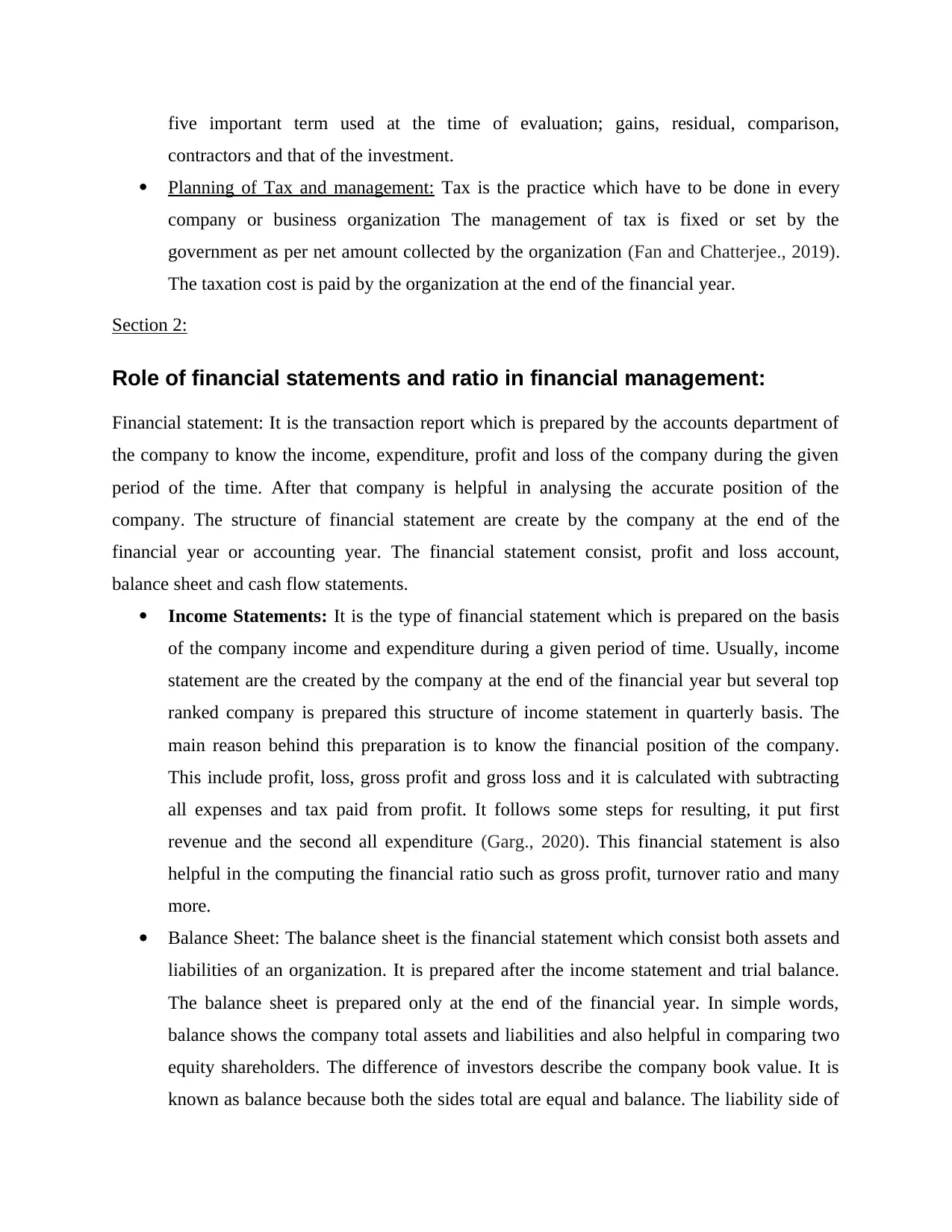
five important term used at the time of evaluation; gains, residual, comparison,
contractors and that of the investment.
Planning of Tax and management: Tax is the practice which have to be done in every
company or business organization The management of tax is fixed or set by the
government as per net amount collected by the organization (Fan and Chatterjee., 2019).
The taxation cost is paid by the organization at the end of the financial year.
Section 2:
Role of financial statements and ratio in financial management:
Financial statement: It is the transaction report which is prepared by the accounts department of
the company to know the income, expenditure, profit and loss of the company during the given
period of the time. After that company is helpful in analysing the accurate position of the
company. The structure of financial statement are create by the company at the end of the
financial year or accounting year. The financial statement consist, profit and loss account,
balance sheet and cash flow statements.
Income Statements: It is the type of financial statement which is prepared on the basis
of the company income and expenditure during a given period of time. Usually, income
statement are the created by the company at the end of the financial year but several top
ranked company is prepared this structure of income statement in quarterly basis. The
main reason behind this preparation is to know the financial position of the company.
This include profit, loss, gross profit and gross loss and it is calculated with subtracting
all expenses and tax paid from profit. It follows some steps for resulting, it put first
revenue and the second all expenditure (Garg., 2020). This financial statement is also
helpful in the computing the financial ratio such as gross profit, turnover ratio and many
more.
Balance Sheet: The balance sheet is the financial statement which consist both assets and
liabilities of an organization. It is prepared after the income statement and trial balance.
The balance sheet is prepared only at the end of the financial year. In simple words,
balance shows the company total assets and liabilities and also helpful in comparing two
equity shareholders. The difference of investors describe the company book value. It is
known as balance because both the sides total are equal and balance. The liability side of
contractors and that of the investment.
Planning of Tax and management: Tax is the practice which have to be done in every
company or business organization The management of tax is fixed or set by the
government as per net amount collected by the organization (Fan and Chatterjee., 2019).
The taxation cost is paid by the organization at the end of the financial year.
Section 2:
Role of financial statements and ratio in financial management:
Financial statement: It is the transaction report which is prepared by the accounts department of
the company to know the income, expenditure, profit and loss of the company during the given
period of the time. After that company is helpful in analysing the accurate position of the
company. The structure of financial statement are create by the company at the end of the
financial year or accounting year. The financial statement consist, profit and loss account,
balance sheet and cash flow statements.
Income Statements: It is the type of financial statement which is prepared on the basis
of the company income and expenditure during a given period of time. Usually, income
statement are the created by the company at the end of the financial year but several top
ranked company is prepared this structure of income statement in quarterly basis. The
main reason behind this preparation is to know the financial position of the company.
This include profit, loss, gross profit and gross loss and it is calculated with subtracting
all expenses and tax paid from profit. It follows some steps for resulting, it put first
revenue and the second all expenditure (Garg., 2020). This financial statement is also
helpful in the computing the financial ratio such as gross profit, turnover ratio and many
more.
Balance Sheet: The balance sheet is the financial statement which consist both assets and
liabilities of an organization. It is prepared after the income statement and trial balance.
The balance sheet is prepared only at the end of the financial year. In simple words,
balance shows the company total assets and liabilities and also helpful in comparing two
equity shareholders. The difference of investors describe the company book value. It is
known as balance because both the sides total are equal and balance. The liability side of
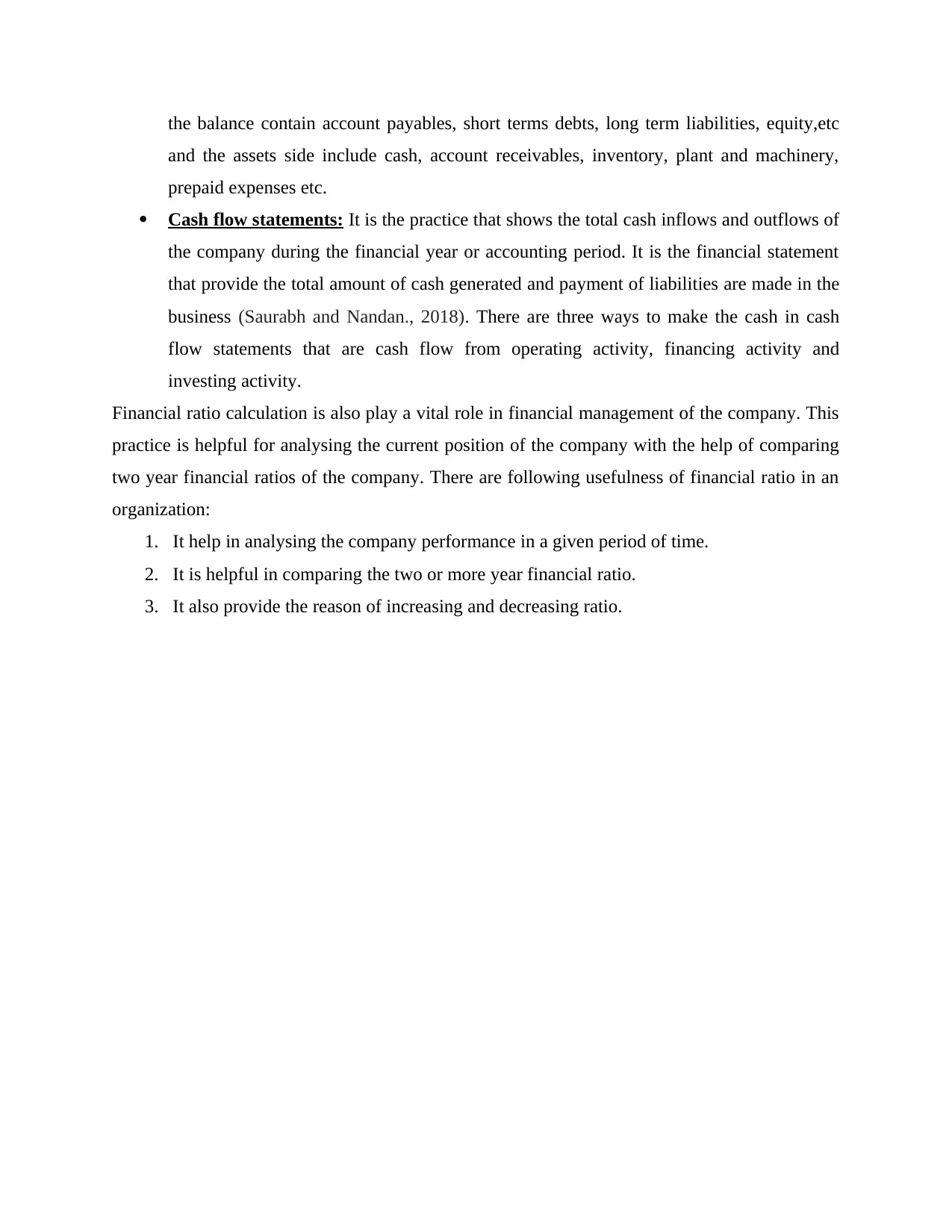
the balance contain account payables, short terms debts, long term liabilities, equity,etc
and the assets side include cash, account receivables, inventory, plant and machinery,
prepaid expenses etc.
Cash flow statements: It is the practice that shows the total cash inflows and outflows of
the company during the financial year or accounting period. It is the financial statement
that provide the total amount of cash generated and payment of liabilities are made in the
business (Saurabh and Nandan., 2018). There are three ways to make the cash in cash
flow statements that are cash flow from operating activity, financing activity and
investing activity.
Financial ratio calculation is also play a vital role in financial management of the company. This
practice is helpful for analysing the current position of the company with the help of comparing
two year financial ratios of the company. There are following usefulness of financial ratio in an
organization:
1. It help in analysing the company performance in a given period of time.
2. It is helpful in comparing the two or more year financial ratio.
3. It also provide the reason of increasing and decreasing ratio.
and the assets side include cash, account receivables, inventory, plant and machinery,
prepaid expenses etc.
Cash flow statements: It is the practice that shows the total cash inflows and outflows of
the company during the financial year or accounting period. It is the financial statement
that provide the total amount of cash generated and payment of liabilities are made in the
business (Saurabh and Nandan., 2018). There are three ways to make the cash in cash
flow statements that are cash flow from operating activity, financing activity and
investing activity.
Financial ratio calculation is also play a vital role in financial management of the company. This
practice is helpful for analysing the current position of the company with the help of comparing
two year financial ratios of the company. There are following usefulness of financial ratio in an
organization:
1. It help in analysing the company performance in a given period of time.
2. It is helpful in comparing the two or more year financial ratio.
3. It also provide the reason of increasing and decreasing ratio.
You're viewing a preview
Unlock full access by subscribing today!
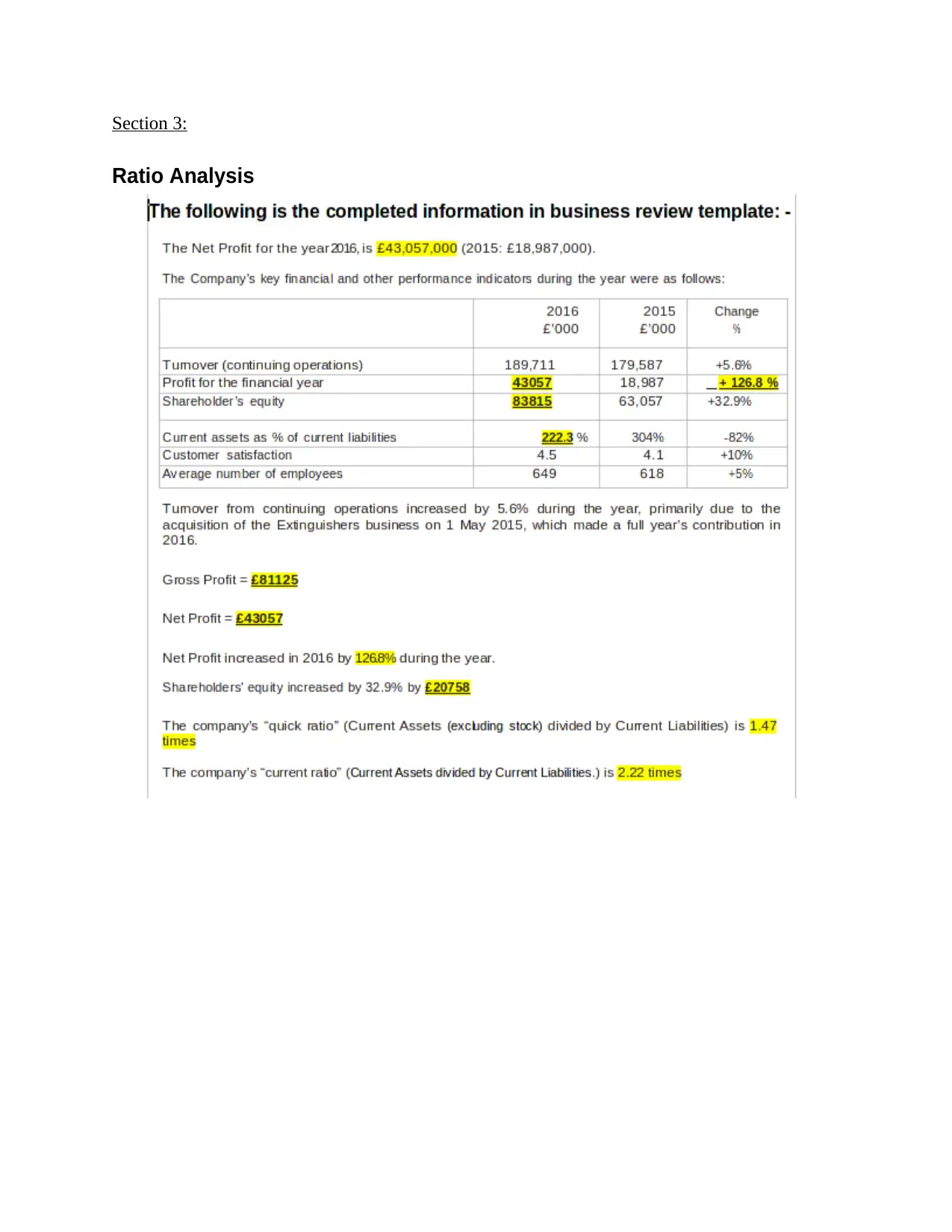
Section 3:
Ratio Analysis
Ratio Analysis
Paraphrase This Document
Need a fresh take? Get an instant paraphrase of this document with our AI Paraphraser
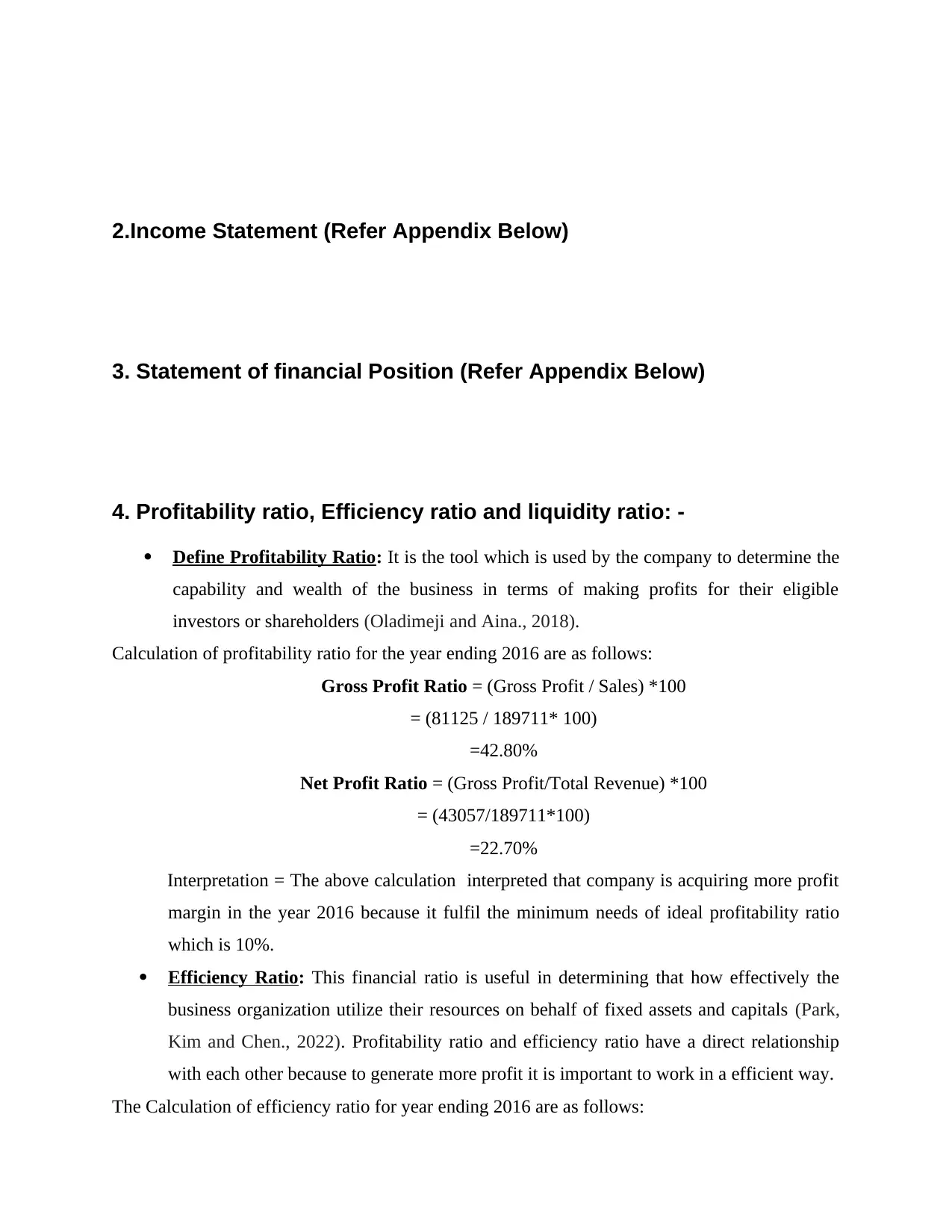
2.Income Statement (Refer Appendix Below)
3. Statement of financial Position (Refer Appendix Below)
4. Profitability ratio, Efficiency ratio and liquidity ratio: -
Define Profitability Ratio: It is the tool which is used by the company to determine the
capability and wealth of the business in terms of making profits for their eligible
investors or shareholders (Oladimeji and Aina., 2018).
Calculation of profitability ratio for the year ending 2016 are as follows:
Gross Profit Ratio = (Gross Profit / Sales) *100
= (81125 / 189711* 100)
=42.80%
Net Profit Ratio = (Gross Profit/Total Revenue) *100
= (43057/189711*100)
=22.70%
Interpretation = The above calculation interpreted that company is acquiring more profit
margin in the year 2016 because it fulfil the minimum needs of ideal profitability ratio
which is 10%.
Efficiency Ratio: This financial ratio is useful in determining that how effectively the
business organization utilize their resources on behalf of fixed assets and capitals (Park,
Kim and Chen., 2022). Profitability ratio and efficiency ratio have a direct relationship
with each other because to generate more profit it is important to work in a efficient way.
The Calculation of efficiency ratio for year ending 2016 are as follows:
3. Statement of financial Position (Refer Appendix Below)
4. Profitability ratio, Efficiency ratio and liquidity ratio: -
Define Profitability Ratio: It is the tool which is used by the company to determine the
capability and wealth of the business in terms of making profits for their eligible
investors or shareholders (Oladimeji and Aina., 2018).
Calculation of profitability ratio for the year ending 2016 are as follows:
Gross Profit Ratio = (Gross Profit / Sales) *100
= (81125 / 189711* 100)
=42.80%
Net Profit Ratio = (Gross Profit/Total Revenue) *100
= (43057/189711*100)
=22.70%
Interpretation = The above calculation interpreted that company is acquiring more profit
margin in the year 2016 because it fulfil the minimum needs of ideal profitability ratio
which is 10%.
Efficiency Ratio: This financial ratio is useful in determining that how effectively the
business organization utilize their resources on behalf of fixed assets and capitals (Park,
Kim and Chen., 2022). Profitability ratio and efficiency ratio have a direct relationship
with each other because to generate more profit it is important to work in a efficient way.
The Calculation of efficiency ratio for year ending 2016 are as follows:
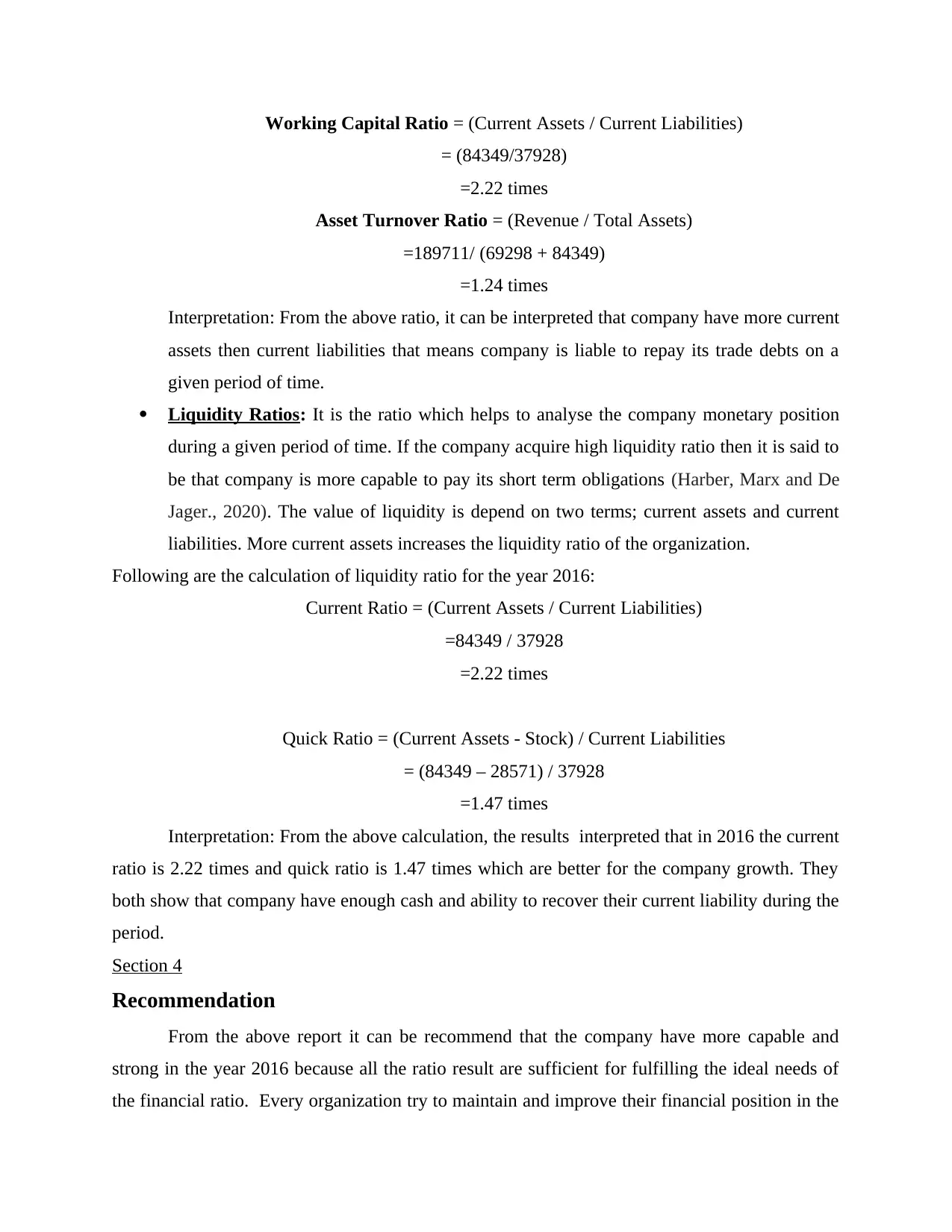
Working Capital Ratio = (Current Assets / Current Liabilities)
= (84349/37928)
=2.22 times
Asset Turnover Ratio = (Revenue / Total Assets)
=189711/ (69298 + 84349)
=1.24 times
Interpretation: From the above ratio, it can be interpreted that company have more current
assets then current liabilities that means company is liable to repay its trade debts on a
given period of time.
Liquidity Ratios: It is the ratio which helps to analyse the company monetary position
during a given period of time. If the company acquire high liquidity ratio then it is said to
be that company is more capable to pay its short term obligations (Harber, Marx and De
Jager., 2020). The value of liquidity is depend on two terms; current assets and current
liabilities. More current assets increases the liquidity ratio of the organization.
Following are the calculation of liquidity ratio for the year 2016:
Current Ratio = (Current Assets / Current Liabilities)
=84349 / 37928
=2.22 times
Quick Ratio = (Current Assets - Stock) / Current Liabilities
= (84349 – 28571) / 37928
=1.47 times
Interpretation: From the above calculation, the results interpreted that in 2016 the current
ratio is 2.22 times and quick ratio is 1.47 times which are better for the company growth. They
both show that company have enough cash and ability to recover their current liability during the
period.
Section 4
Recommendation
From the above report it can be recommend that the company have more capable and
strong in the year 2016 because all the ratio result are sufficient for fulfilling the ideal needs of
the financial ratio. Every organization try to maintain and improve their financial position in the
= (84349/37928)
=2.22 times
Asset Turnover Ratio = (Revenue / Total Assets)
=189711/ (69298 + 84349)
=1.24 times
Interpretation: From the above ratio, it can be interpreted that company have more current
assets then current liabilities that means company is liable to repay its trade debts on a
given period of time.
Liquidity Ratios: It is the ratio which helps to analyse the company monetary position
during a given period of time. If the company acquire high liquidity ratio then it is said to
be that company is more capable to pay its short term obligations (Harber, Marx and De
Jager., 2020). The value of liquidity is depend on two terms; current assets and current
liabilities. More current assets increases the liquidity ratio of the organization.
Following are the calculation of liquidity ratio for the year 2016:
Current Ratio = (Current Assets / Current Liabilities)
=84349 / 37928
=2.22 times
Quick Ratio = (Current Assets - Stock) / Current Liabilities
= (84349 – 28571) / 37928
=1.47 times
Interpretation: From the above calculation, the results interpreted that in 2016 the current
ratio is 2.22 times and quick ratio is 1.47 times which are better for the company growth. They
both show that company have enough cash and ability to recover their current liability during the
period.
Section 4
Recommendation
From the above report it can be recommend that the company have more capable and
strong in the year 2016 because all the ratio result are sufficient for fulfilling the ideal needs of
the financial ratio. Every organization try to maintain and improve their financial position in the
You're viewing a preview
Unlock full access by subscribing today!
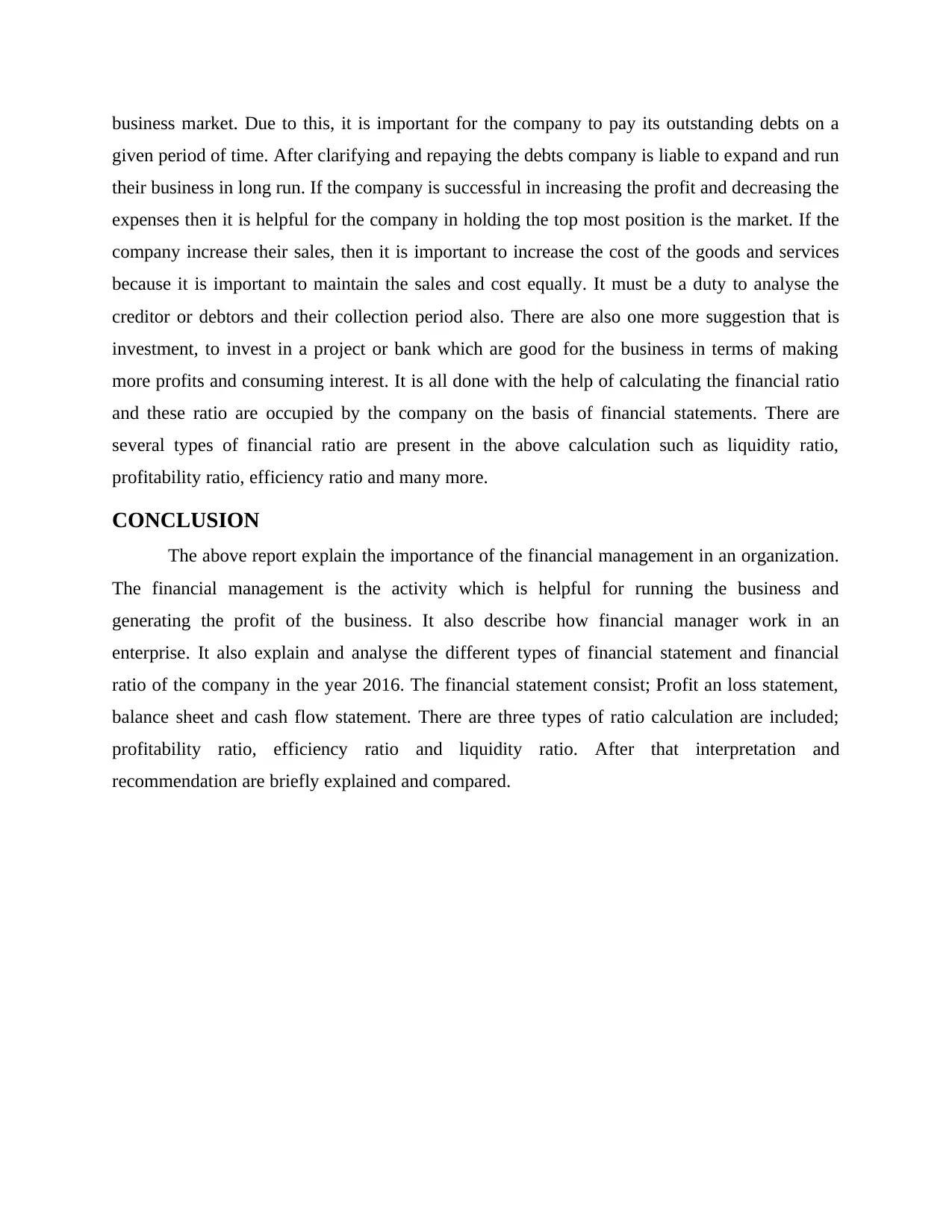
business market. Due to this, it is important for the company to pay its outstanding debts on a
given period of time. After clarifying and repaying the debts company is liable to expand and run
their business in long run. If the company is successful in increasing the profit and decreasing the
expenses then it is helpful for the company in holding the top most position is the market. If the
company increase their sales, then it is important to increase the cost of the goods and services
because it is important to maintain the sales and cost equally. It must be a duty to analyse the
creditor or debtors and their collection period also. There are also one more suggestion that is
investment, to invest in a project or bank which are good for the business in terms of making
more profits and consuming interest. It is all done with the help of calculating the financial ratio
and these ratio are occupied by the company on the basis of financial statements. There are
several types of financial ratio are present in the above calculation such as liquidity ratio,
profitability ratio, efficiency ratio and many more.
CONCLUSION
The above report explain the importance of the financial management in an organization.
The financial management is the activity which is helpful for running the business and
generating the profit of the business. It also describe how financial manager work in an
enterprise. It also explain and analyse the different types of financial statement and financial
ratio of the company in the year 2016. The financial statement consist; Profit an loss statement,
balance sheet and cash flow statement. There are three types of ratio calculation are included;
profitability ratio, efficiency ratio and liquidity ratio. After that interpretation and
recommendation are briefly explained and compared.
given period of time. After clarifying and repaying the debts company is liable to expand and run
their business in long run. If the company is successful in increasing the profit and decreasing the
expenses then it is helpful for the company in holding the top most position is the market. If the
company increase their sales, then it is important to increase the cost of the goods and services
because it is important to maintain the sales and cost equally. It must be a duty to analyse the
creditor or debtors and their collection period also. There are also one more suggestion that is
investment, to invest in a project or bank which are good for the business in terms of making
more profits and consuming interest. It is all done with the help of calculating the financial ratio
and these ratio are occupied by the company on the basis of financial statements. There are
several types of financial ratio are present in the above calculation such as liquidity ratio,
profitability ratio, efficiency ratio and many more.
CONCLUSION
The above report explain the importance of the financial management in an organization.
The financial management is the activity which is helpful for running the business and
generating the profit of the business. It also describe how financial manager work in an
enterprise. It also explain and analyse the different types of financial statement and financial
ratio of the company in the year 2016. The financial statement consist; Profit an loss statement,
balance sheet and cash flow statement. There are three types of ratio calculation are included;
profitability ratio, efficiency ratio and liquidity ratio. After that interpretation and
recommendation are briefly explained and compared.
Paraphrase This Document
Need a fresh take? Get an instant paraphrase of this document with our AI Paraphraser
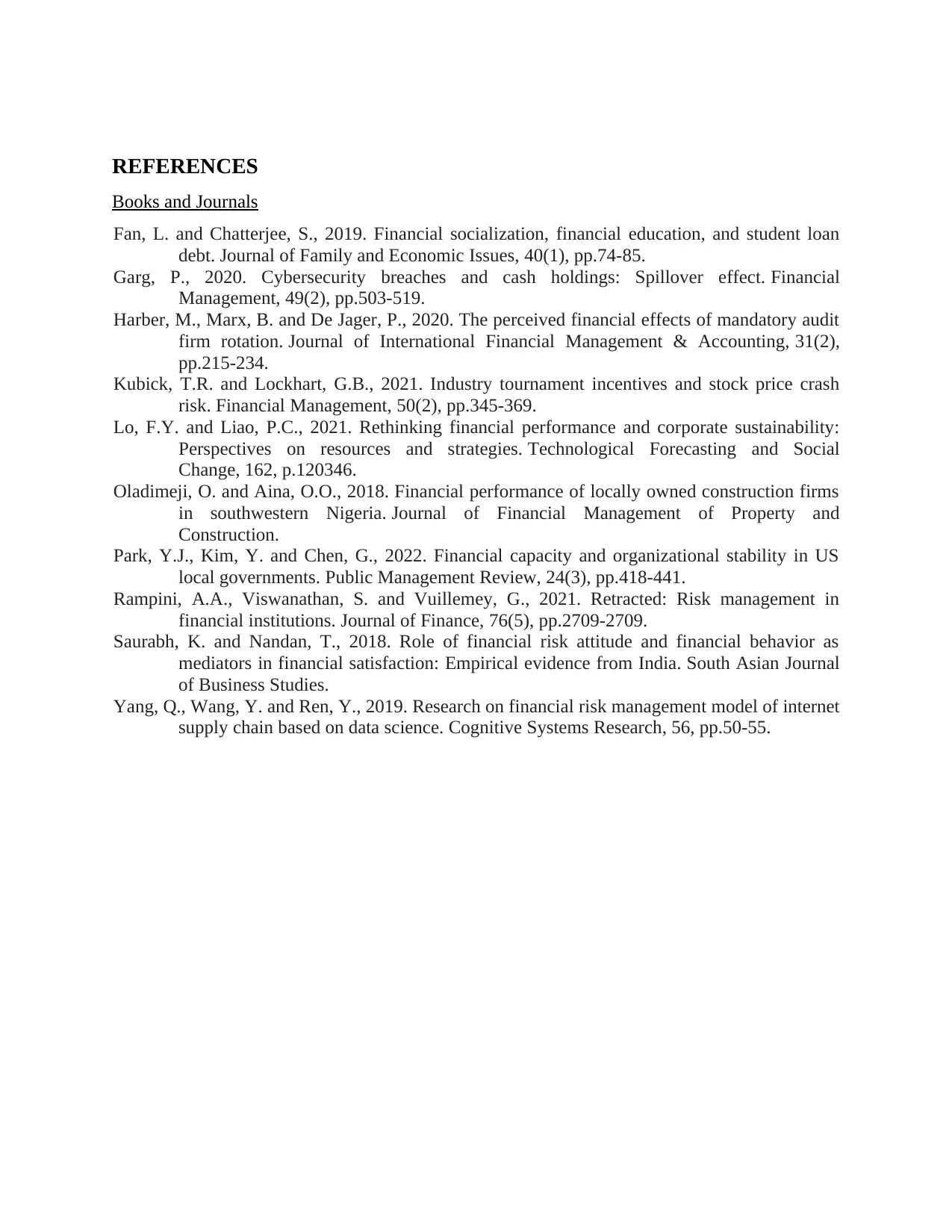
REFERENCES
Books and Journals
Fan, L. and Chatterjee, S., 2019. Financial socialization, financial education, and student loan
debt. Journal of Family and Economic Issues, 40(1), pp.74-85.
Garg, P., 2020. Cybersecurity breaches and cash holdings: Spillover effect. Financial
Management, 49(2), pp.503-519.
Harber, M., Marx, B. and De Jager, P., 2020. The perceived financial effects of mandatory audit
firm rotation. Journal of International Financial Management & Accounting, 31(2),
pp.215-234.
Kubick, T.R. and Lockhart, G.B., 2021. Industry tournament incentives and stock price crash
risk. Financial Management, 50(2), pp.345-369.
Lo, F.Y. and Liao, P.C., 2021. Rethinking financial performance and corporate sustainability:
Perspectives on resources and strategies. Technological Forecasting and Social
Change, 162, p.120346.
Oladimeji, O. and Aina, O.O., 2018. Financial performance of locally owned construction firms
in southwestern Nigeria. Journal of Financial Management of Property and
Construction.
Park, Y.J., Kim, Y. and Chen, G., 2022. Financial capacity and organizational stability in US
local governments. Public Management Review, 24(3), pp.418-441.
Rampini, A.A., Viswanathan, S. and Vuillemey, G., 2021. Retracted: Risk management in
financial institutions. Journal of Finance, 76(5), pp.2709-2709.
Saurabh, K. and Nandan, T., 2018. Role of financial risk attitude and financial behavior as
mediators in financial satisfaction: Empirical evidence from India. South Asian Journal
of Business Studies.
Yang, Q., Wang, Y. and Ren, Y., 2019. Research on financial risk management model of internet
supply chain based on data science. Cognitive Systems Research, 56, pp.50-55.
Books and Journals
Fan, L. and Chatterjee, S., 2019. Financial socialization, financial education, and student loan
debt. Journal of Family and Economic Issues, 40(1), pp.74-85.
Garg, P., 2020. Cybersecurity breaches and cash holdings: Spillover effect. Financial
Management, 49(2), pp.503-519.
Harber, M., Marx, B. and De Jager, P., 2020. The perceived financial effects of mandatory audit
firm rotation. Journal of International Financial Management & Accounting, 31(2),
pp.215-234.
Kubick, T.R. and Lockhart, G.B., 2021. Industry tournament incentives and stock price crash
risk. Financial Management, 50(2), pp.345-369.
Lo, F.Y. and Liao, P.C., 2021. Rethinking financial performance and corporate sustainability:
Perspectives on resources and strategies. Technological Forecasting and Social
Change, 162, p.120346.
Oladimeji, O. and Aina, O.O., 2018. Financial performance of locally owned construction firms
in southwestern Nigeria. Journal of Financial Management of Property and
Construction.
Park, Y.J., Kim, Y. and Chen, G., 2022. Financial capacity and organizational stability in US
local governments. Public Management Review, 24(3), pp.418-441.
Rampini, A.A., Viswanathan, S. and Vuillemey, G., 2021. Retracted: Risk management in
financial institutions. Journal of Finance, 76(5), pp.2709-2709.
Saurabh, K. and Nandan, T., 2018. Role of financial risk attitude and financial behavior as
mediators in financial satisfaction: Empirical evidence from India. South Asian Journal
of Business Studies.
Yang, Q., Wang, Y. and Ren, Y., 2019. Research on financial risk management model of internet
supply chain based on data science. Cognitive Systems Research, 56, pp.50-55.
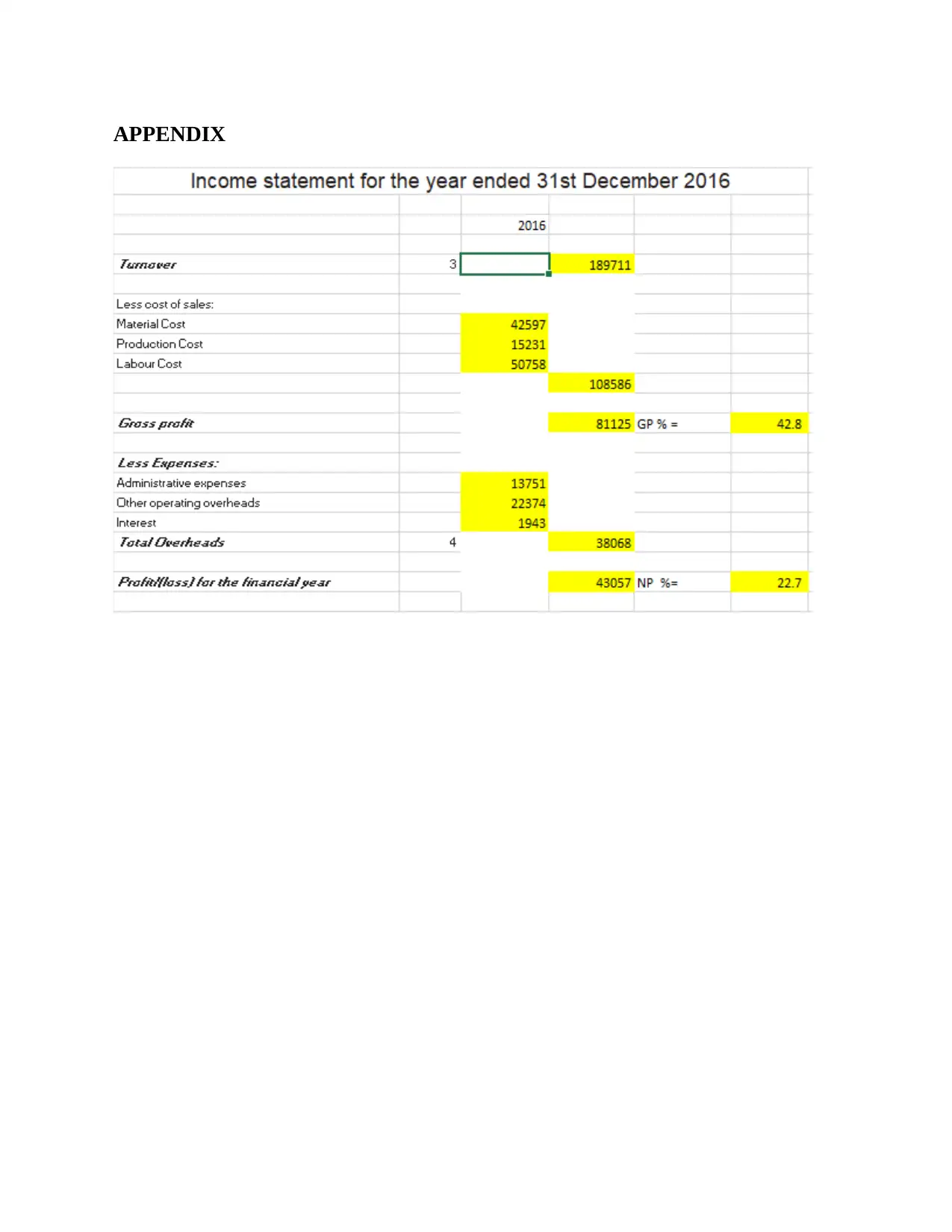
APPENDIX
You're viewing a preview
Unlock full access by subscribing today!
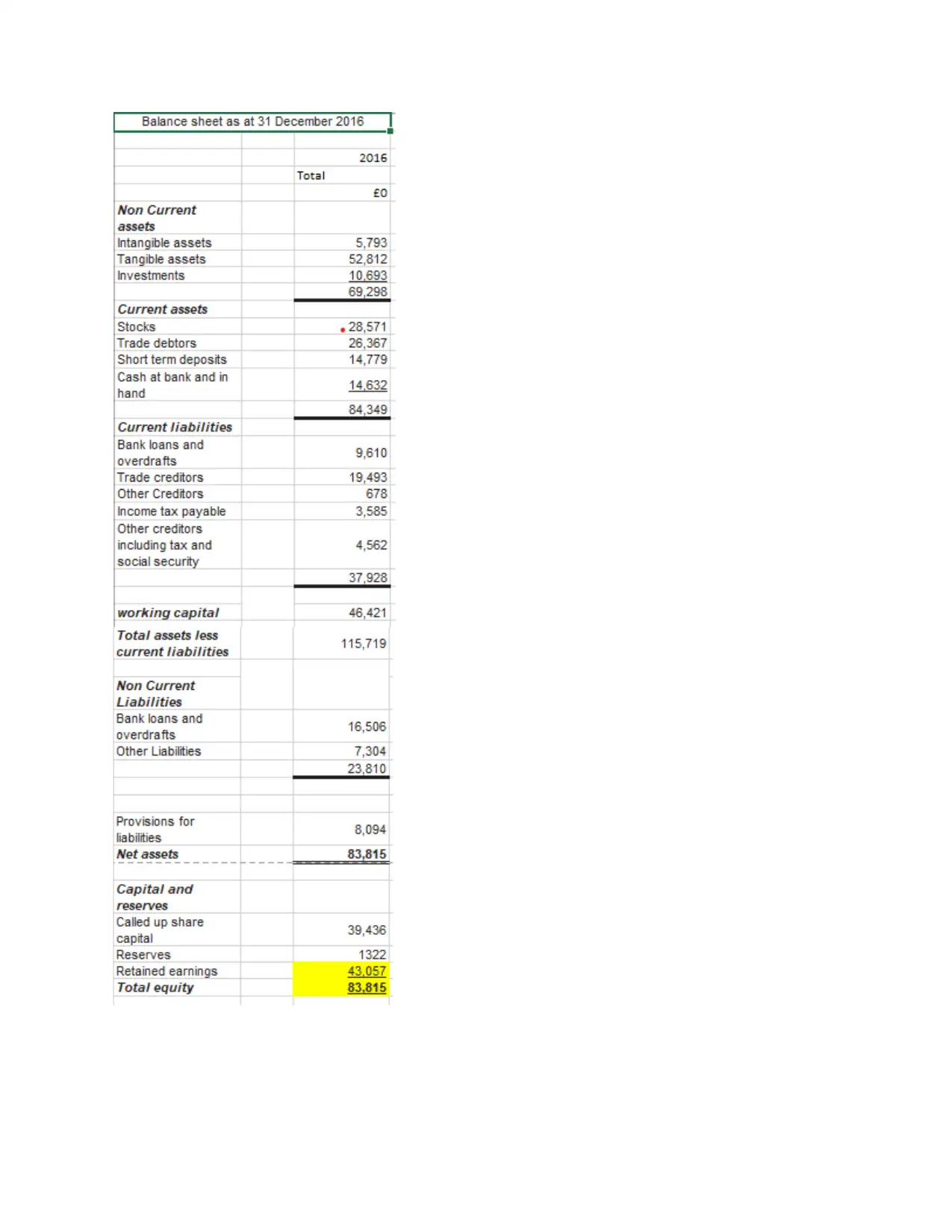
Paraphrase This Document
Need a fresh take? Get an instant paraphrase of this document with our AI Paraphraser
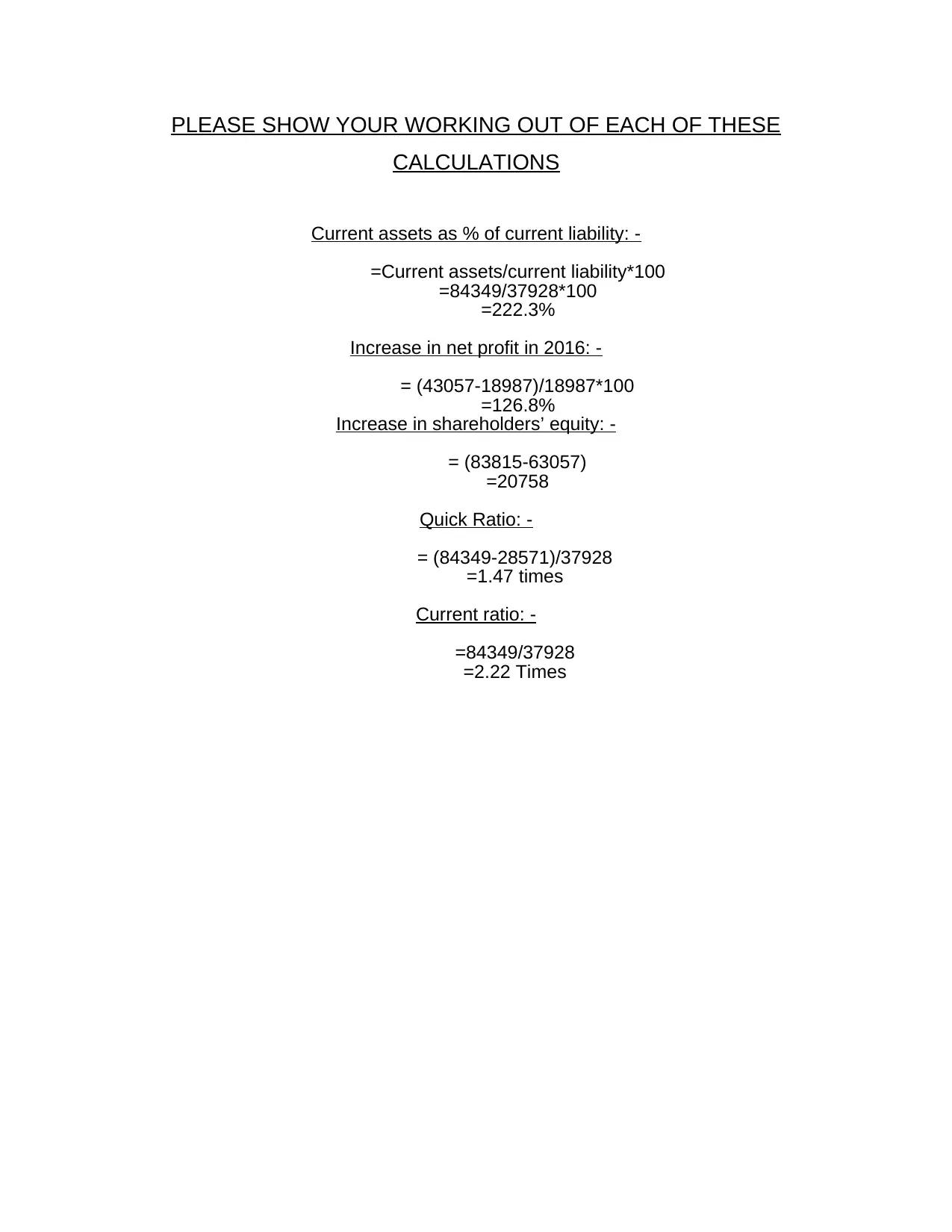
PLEASE SHOW YOUR WORKING OUT OF EACH OF THESE
CALCULATIONS
Current assets as % of current liability: -
=Current assets/current liability*100
=84349/37928*100
=222.3%
Increase in net profit in 2016: -
= (43057-18987)/18987*100
=126.8%
Increase in shareholders’ equity: -
= (83815-63057)
=20758
Quick Ratio: -
= (84349-28571)/37928
=1.47 times
Current ratio: -
=84349/37928
=2.22 Times
CALCULATIONS
Current assets as % of current liability: -
=Current assets/current liability*100
=84349/37928*100
=222.3%
Increase in net profit in 2016: -
= (43057-18987)/18987*100
=126.8%
Increase in shareholders’ equity: -
= (83815-63057)
=20758
Quick Ratio: -
= (84349-28571)/37928
=1.47 times
Current ratio: -
=84349/37928
=2.22 Times
1 out of 14
Related Documents
Your All-in-One AI-Powered Toolkit for Academic Success.
+13062052269
info@desklib.com
Available 24*7 on WhatsApp / Email
![[object Object]](/_next/static/media/star-bottom.7253800d.svg)
Unlock your academic potential
© 2024 | Zucol Services PVT LTD | All rights reserved.



